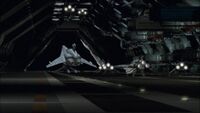m Text replacement - "(33)" to "{{TRS|33}}" |
m minor cleanup Tags: Visual edit Disambiguation links |
||
| (3 intermediate revisions by the same user not shown) | |||
| Line 1: | Line 1: | ||
[[Image:Combatlanding2.jpg|thumb|200px|Vipers during the chaotic combat landing in the [[Battle of Ragnar Anchorage]]. | [[Image:Combatlanding2.jpg|thumb|200px|Vipers during the chaotic combat landing in the [[Battle of Ragnar Anchorage]] {{TRS|Miniseries, Night 2}}.]] | ||
A '''combat landing''' is performed in combat situations where retreat is necessary and a battlestar must leave the combat zone immediately. A combat landing is a drastic form of a non-combat [[Hands-on Approach|hands-on approach]]. | A '''combat landing''' is performed in combat situations where retreat is necessary and a [[Battlestar (RDM)|battlestar]] must leave the combat zone immediately. A combat landing is a drastic form of a non-combat [[Hands-on Approach|hands-on approach]]. | ||
Combat landings are usually performed for speed with less emphasis on safety. During a combat landing, fighters do not care about where they land in the [[Landing bay|landing bay]], as long as they can set down on it. The pilots will activate their magnetic clamps and try to skid along the landing bay until the clamps catch and halt the ship. Divots are knocked into the landing bay deck by the skidding undercarriage, and they later need to be pounded out | Combat landings are usually performed for speed with less emphasis on safety. During a combat landing, fighters do not care about where they land in the [[Landing bay|landing bay]], as long as they can set down on it. The pilots will activate their magnetic clamps and try to skid along the landing bay until the clamps catch and halt the ship. Divots and dents are knocked into the landing bay deck by the skidding undercarriage, and they later need to be pounded out. | ||
Combat landings can be very risky for '' | Combat landings can be very risky for ''{{RDM|Galactica}}'' pilots since only the port landing bay is available; the starboard pod was being converted into a pressurized museum at the time of the [[Cylon Attack]]. Combat landings by a full squadron may make it very cramped for parking within the pod and increase the likelihood of collisions. Further, ''Galactica'' may begin retracting her [[Flight pod|flight pods]] early, requiring a pilot to fly as accurately as they can to enter the landing pod without colliding with the ship {{TRS|Miniseries, Night 2|33}}. | ||
On the other end of the spectrum, combat landings on a [[Mercury class battlestar]] such as ''[[Pegasus (RDM)|Pegasus]]'' are a much more orderly affair, thanks to having four times the landing space of ''Galactica'' | On the other end of the spectrum, combat landings on a [[Mercury class battlestar]] such as ''[[Pegasus (RDM)|Pegasus]]'' are a much more orderly affair, thanks to having four times the landing space of ''Galactica'' {{TRS|The Captain's Hand}}. | ||
For 239 of the 240 jumps that '' | For 239 of the 240 jumps that ''{{RDM|Galactica}}'' and the Fleet make to escape the [[Cylons (RDM)|Cylons]] after the initial [[Battle of Ragnar Anchorage]], combat landings are used to the point that the pilots must check their undercarriages before each launch to check for structural problems because of the stress placed on the fighters {{TRS|33}}. | ||
[[Category:A to Z]] | [[Category:A to Z]] | ||
Latest revision as of 05:53, 8 January 2024

A combat landing is performed in combat situations where retreat is necessary and a battlestar must leave the combat zone immediately. A combat landing is a drastic form of a non-combat hands-on approach.
Combat landings are usually performed for speed with less emphasis on safety. During a combat landing, fighters do not care about where they land in the landing bay, as long as they can set down on it. The pilots will activate their magnetic clamps and try to skid along the landing bay until the clamps catch and halt the ship. Divots and dents are knocked into the landing bay deck by the skidding undercarriage, and they later need to be pounded out.
Combat landings can be very risky for Galactica pilots since only the port landing bay is available; the starboard pod was being converted into a pressurized museum at the time of the Cylon Attack. Combat landings by a full squadron may make it very cramped for parking within the pod and increase the likelihood of collisions. Further, Galactica may begin retracting her flight pods early, requiring a pilot to fly as accurately as they can to enter the landing pod without colliding with the ship (TRS: "Miniseries, Night 2", "33").
On the other end of the spectrum, combat landings on a Mercury class battlestar such as Pegasus are a much more orderly affair, thanks to having four times the landing space of Galactica (TRS: "The Captain's Hand").
For 239 of the 240 jumps that Galactica and the Fleet make to escape the Cylons after the initial Battle of Ragnar Anchorage, combat landings are used to the point that the pilots must check their undercarriages before each launch to check for structural problems because of the stress placed on the fighters (TRS: "33").
